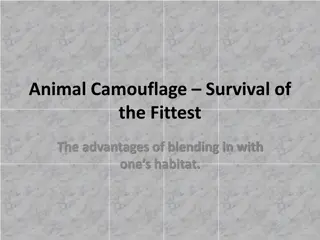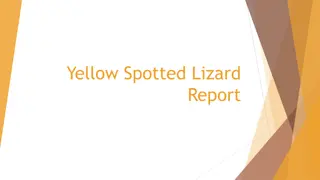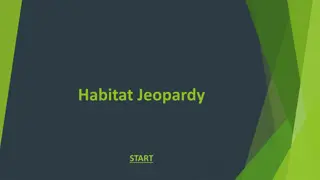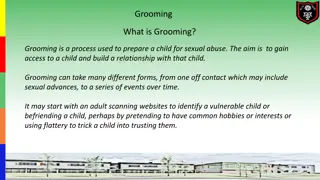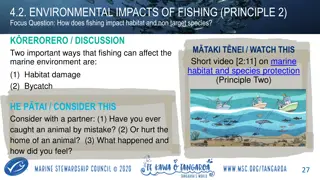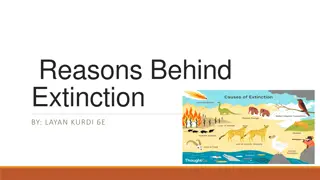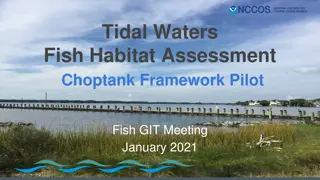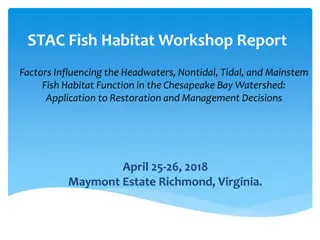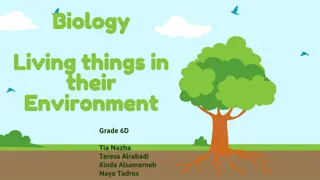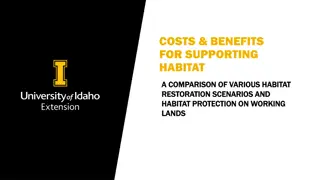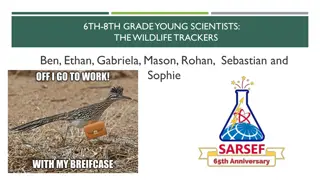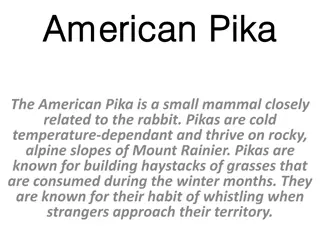Understanding Dangers to Animals: Predators and Habitat Loss
Animals face various dangers in their natural habitats, including predators and habitat loss. Predators like owls, bobcats, and racoons hunt other animals, while habitat loss, such as the melting Arctic ice cap, threatens species like polar bears. Human activities, like beach development, also impact animals like birds and sea turtles. Awareness and conservation efforts are crucial to protect these vulnerable species.
Download Presentation

Please find below an Image/Link to download the presentation.
The content on the website is provided AS IS for your information and personal use only. It may not be sold, licensed, or shared on other websites without obtaining consent from the author. Download presentation by click this link. If you encounter any issues during the download, it is possible that the publisher has removed the file from their server.
E N D
Presentation Transcript
Dangers to Animals Text Talk Week 6, Day 1
Slide 1 DANGER! A danger is something that might cause hurt or harm. Fire is an example of a danger. Small objects can be dangerous for babies if they put them in their mouths. What dangers do animals encounter? Let s find out!
Slide 2 Predators One danger that animals encounter is predators, animals that hunt other animals. Owls are predators of insects, smaller birds, and small mammals like mice. Owls use their sharp talons to capture their prey.
Slide 3 Even though bobcats are predators, they need to keep their offspring safe. A mother bobcat has several different dens while she raises her kittens. She moves them from place to place to keep them safe from other predators. Bobcats live deep in forests in many states. They hunt at night for rabbits, squirrels, birds, and snakes.
Slide 4 Racoons mostly hunt for small animals such as frogs, fish, crayfish, insects, rodents, and bird eggs. Racoons are predators of sea turtles. They dig up sea turtle eggs and eat them.
Slide 5 Polar bears use the ice as a platform for hunting. Habitat Loss Another danger animals encounter is habitat loss, when the places they depend on become smaller. Everything a polar bear eats, like seals, eats another animal or plant that also depends on the icy habitat. Our Earth is getting warmer. Warmer temperatures cause ice to melt. As ice melts, the polar bear habitat shrinks. The ice-covered water of the Arctic is the only place polar bears live.
Slide 6 This map shows how the Arctic ice cap, the habitat for polar bears, has changed as the Earth s temperatures have warmed.
Slide 7 Many people like to live and play on beaches. What happens to animals that depend on the beach and nearby water for their habitat?
Slide 8 Birds and sea turtles use the sandy beach for making nests. People walking on a beach can be a danger to these animals.
Slide 9 The Florida panther lives in wetlands, swamps, and forests. Florida panthers are endangered by the loss of their habitat, as people have built homes and roads. There are not very many Florida panthers left. They live in a small, protected area of Florida.
Slide 10 This map shows the area where Florida panthers used to live, and where they live now. Florida is part of the United States.
Slide 11 Monarchs lay their eggs on the plant s leaves so that the caterpillars have food to eat when they hatch. Monarch butterflies depend on finding milkweed in their habitat. Where there is not enough milkweed, the monarchs are in danger.
Slide 12 Loss of habitat is the greatest danger to animals in the United States.
Slide 13 Drought Wild horses in Colorado in the United States and zebras in South Africa drink from water holes and rivers. Sometimes animals encounter drought a shortage of water. When there is not enough rain to fill rivers, lakes, and ponds, animals are thirsty. They may need to travel long distances to find the water they need to survive.
Slide 14 Zebras in South Africa Wild horses in Colorado in the United States Animals all over the world experience drought.
Slide 15 Trash Another serious danger that animals encounter is trash, especially in the ocean. Seals, whales, sea birds, and sea turtles can get tangled up in trash.
Slide 16 Sea turtles live in oceans around the world, including in the Atlantic Ocean, near Boston. Sea turtles can live to be 80 years old or more. But sea turtles are endangered. Sea turtles eat jellyfish. But a plastic bag can look like a jellyfish. What happens when a sea turtle eats a plastic bag?
Slide 17 Researchers put up signs to inform people about turtle nesting areas and about what they can do to help protect sea turtles. Sea turtles are at risk when they encounter plastic in the ocean. Animals face natural dangers, like predators and drought. Animals also face dangers that are not natural. People can take action to lessen dangers to animals.
Written and compiled by Melissa Tonachel and Fay Ferency, Focus on First, 2019. Citations Slide 1: http://discovermagazine.com/2013/jan-feb/49-humans-had-mastered-fire-by-1000000-bc, https://www.naeyc.org/our-work/families/understanding- and-responding-children-who-bite Slide 2: http://zoo.avantia.net/photos/4927 Slide 3: https://www.trails.com/list_1967_predatory-mammals-new-england.html Slide 4: image from Turtle Tide, illustrated by Bruce Hiscock Slide 5: http://www.outwardon.com/article/animals-adapting-changing-climate/ Slide 6: https://i.cbc.ca/1.2505132.1390323250!/fileImage/httpImage/image.jpg_gen/derivatives/16x9_780/hi-climate-change-852-jpg.jpg Slide 7: https://celebrating200years.noaa.gov/events/conservstewards/image7.html Slide 8: http://www.biodiversitya-z.org/content/turtle-nesting-site; http://ternandplover.unl.edu/plover/nesteggchick-plover.asp; http://therealcape.com/piping-plover-situation-crazy-defies-logic/; https://verovine.com/news/protect-the-sea-turtles/ Slide 9: https://www.fws.gov/endangered/news/episodes/bu-spring2015/story1/index.html Slide 10: http://blogs.ifas.ufl.edu/wecdept/2016/05/11/intervene-not-intervene-individual-based-approach-dynamics-persistence-florida-panther-population/ Slide 11: https://www.savatree.com/blog/2015/01/milkweed-monarchs/; https://eatreadscience.com/2015/11/08/resistance-to-plant-toxins-in-milkweed- butterflies-is-linked-to-toxin-storage-for-defense/ Slide 12: https://wwf.panda.org/?209005/Increased-protection-of-polar-bear-habitat; https://www.capecodchamber.org/beaches; https://www.floridapantherprotection.com/Default.aspx?n=4; http://www.bogan.ca/index.php?id=raising-monarch-butterflies Slide 13: https://www.denverpost.com/2018/07/23/colorado-drought-west-wild-horses/; https://blog.nationalgeographic.org/2016/10/03/qa-extreme- drought-in-south-africas-kruger-national-park-how-is-wildlife-faring/ Slide 14: https://www.sccpre.cat/show/hiiox_globe-world-world-map-graphic-design-png-image/ Slide 15: image from Sea Turtles by Laura Marsh; http://www.thesuperfins.com/do-turtles-eat-jellyfish/ Slide 16: https://medium.com/usfws/the-trash-at-the-edge-of-the-world-47049d25e464 Slide 17: https://blogs.wwf.org.uk/blog/habitats/oceans/marine-turtles-and-plastics/; https://www.stateparks.org/sc-sea-turtles-finding-sc-beaches-more-often-for-nesting/


